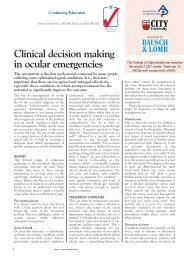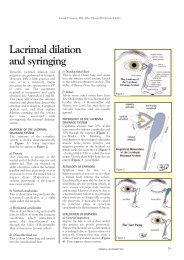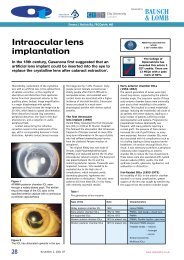You also want an ePaper? Increase the reach of your titles
YUMPU automatically turns print PDFs into web optimized ePapers that Google loves.
CONTINUING EDUCATION AND TRAINING<br />
Gain 2 CET credits - enter online at www.otcet.co.uk or by post<br />
Figure 9 The same eye as seen in<br />
Figure 8 with a significant increment in <strong>the</strong><br />
optic zone projection illustrating full<br />
corneal clearance.<br />
comparison to <strong>the</strong> corneal thickness, as<br />
shown in Figure 10. The fluorescence can<br />
be seen perfectly well with white light;<br />
cobalt blue filters reduce <strong>the</strong> brightness too<br />
much for <strong>the</strong> corneal thickness to be seen<br />
well.<br />
Apical clearance between 0.2mm and<br />
0.3mm is a satisfactory target for a nonventilated<br />
ScCL, approximately half a normal<br />
corneal thickness, with <strong>the</strong> pre-corneal<br />
fluid reservoir extending just beyond <strong>the</strong><br />
limbus. The exact measurement of corneal<br />
clearance is not critical, although if excessive<br />
it is more difficult to maintain an<br />
air-free pre-corneal fluid reservoir or for <strong>the</strong><br />
patient to insert <strong>the</strong> lens without an air<br />
methods consequent to <strong>the</strong> introduction of<br />
RGP materials. There are many fitting<br />
nuances which could not be covered, and<br />
<strong>the</strong>re are significant problem areas which<br />
have only briefly been touched upon.<br />
However, it is emphasised that <strong>the</strong> fitting<br />
processes have become straightforward and<br />
predictable in most cases, with a rapid<br />
arrival at <strong>the</strong> end-point mostly using nonventilated<br />
preformed RGP designs.<br />
ScCLs may be lens-of-choice when a<br />
result is needed more than at any o<strong>the</strong>r<br />
time. There are no conditions for which <strong>the</strong>y<br />
cannot be considered, so it is clearly necessary<br />
to preserve <strong>the</strong> clinical and manufacturing<br />
skills required . Since <strong>the</strong> introduction of<br />
is defined according to two axially measured<br />
parameters: <strong>the</strong> OZP from <strong>the</strong> extrapolation<br />
of <strong>the</strong> scleral curve measured at <strong>the</strong> apex<br />
and at <strong>the</strong> limbus. These increments are just<br />
clinically significant enough to keep <strong>the</strong><br />
number of lenses in <strong>the</strong> fitting system<br />
manageable. OZP is a function of <strong>the</strong> BSR,<br />
hence if <strong>the</strong> BSR is flattened, <strong>the</strong> OZP needs<br />
to be increased to compensate.<br />
The OZS or OZP for an initial trial lens is<br />
selected from an assessment of <strong>the</strong> overall<br />
corneal profile with <strong>the</strong> naked eye. If inaccurately<br />
estimated, <strong>the</strong>re is no major loss as<br />
<strong>the</strong> first lens inspected in situ gives a clear<br />
indication for subsequent lens selection.<br />
Keratometry and corneal topography are of<br />
limited value as nei<strong>the</strong>r provides any information<br />
about <strong>the</strong> peripheral cornea or <strong>the</strong><br />
projection from <strong>the</strong> sclera.<br />
The parameters are assessed simultaneously<br />
with <strong>the</strong> lens in situ, but <strong>the</strong> initial decision<br />
must be to determine <strong>the</strong> optimum<br />
scleral zone specifications as <strong>the</strong> scleral zone<br />
has an impact on <strong>the</strong> optic zone clearance.<br />
The lens is inserted filled with saline and fluorescein<br />
so that areas where <strong>the</strong> lens is clear<br />
of <strong>the</strong> surface can be easily distinguished<br />
from areas where <strong>the</strong> lens is in contact.<br />
Figures 8 and 9 demonstrate <strong>the</strong> effect of<br />
increasing <strong>the</strong> OZP to reduce corneal contact.<br />
Slit lamp biomicroscopy<br />
assessment of <strong>the</strong> optic zone<br />
If fluorescein is added to <strong>the</strong> saline prior to<br />
insertion, inspection of <strong>the</strong> optic zone using<br />
a cobalt blue filter shows any corneal<br />
contact zones. A slit lamp optical section<br />
can be used to measure <strong>the</strong> optic zone<br />
clearance. A pachometer is not necessary<br />
but <strong>the</strong> depth of <strong>the</strong> pre-corneal reservoir<br />
can be estimated with sufficient accuracy by<br />
Figure 10 Slit lamp optical cross section demonstrating <strong>the</strong> pre-corneal fluid reservoir.<br />
The lens, <strong>the</strong> reservoir and <strong>the</strong> cornea are all clearly seen in cross section. The depth of<br />
<strong>the</strong> reservoir is just less than <strong>the</strong> corneal thickness at <strong>the</strong> visual axis, <strong>the</strong>refore<br />
approximately 0.35mm to 0.4mm. By comparison, <strong>the</strong> cornea is 0.5mm to 0.6mm in<br />
thickness. The reservoir is thinner superiorly, and thicker inferiorly, indicating a degree of<br />
downward displacement of <strong>the</strong> lens. This is a normal feature with non-ventilated RGP<br />
ScCL fitting and does not usually have any detrimental effect (Courtesy of Scott Hau)<br />
bubble. If <strong>the</strong>re is insufficient clearance,<br />
corneal contact zones may reduce comfort<br />
and tolerance. Increasing <strong>the</strong> OZS or OZP by<br />
0.25mm alleviates a compressive central<br />
contact zone to give corneal clearance.<br />
Conclusion<br />
This is paper intended to provide an introduction<br />
to modern scleral contact lens practice,<br />
principally to outline changes in fitting<br />
RGP materials <strong>the</strong>ir application can be made<br />
at all grades of pathology where benefits<br />
can be seen. There remain some problems,<br />
and commitment to clinical practice is a<br />
prime requirement. The pathology may be<br />
active or progressive, so close liaison with<br />
ophthalmology is essential. A small number<br />
of practitioners are needed to maintain a<br />
functional service, but those who are not<br />
directly involved should also be aware of <strong>the</strong><br />
significant developments in recent years.<br />
31 | October 20 | 2006 | OT
















